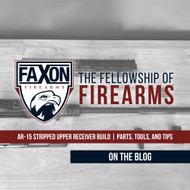AR-15 Stripped Upper Receiver Build | Parts, Tools, and Tips
Posted by refactortactical.com on Apr 17th 2024
Originally posted here.

Building an AR-15 stripped upper receiver involves assembling several key components.
The essential parts include the upper receiver, which may be stripped or assembled, a bolt carrier group (BCG) that is caliber-specific and available in different finishes, and a charging handle that can be mil-spec or ambidextrous.
The barrel, another critical component, must match the intended caliber and can vary in length and finish. Muzzle devices attach to the barrel’s end and are chosen based on personal preference and can include features for flash reduction or recoil management.
The gas system, pivotal for the rifle’s cycling, requires a gas tube and block that must match the barrel’s specifications. Handguards, which provide protection and mounting options for accessories, are selected based on length and configuration preferences.
Now that we’ve outlined the basic structure of an AR-15 stripped upper receiver, let’s get into the individual components and tools required for a successful assembly.
Essential Components for an AR-15 Upper Receiver Assembly
Upper Receiver
The upper receiver serves as the backbone of your AR-15. You can start with either a stripped or a pre-assembled upper receiver. If you choose a stripped one, you will need to add components like the forward assist and the ejection port cover.
Bolt Carrier Group (BCG)
The BCG is the heart of your AR-15, encompassing the bolt itself, the firing pin, and other crucial components. Choosing a BCG that matches your rifle’s caliber and desired durability is important.
Selecting the right Bolt Carrier Group (BCG) is crucial for the performance and reliability of AR-15 rifles. BCGs, often considered the heart of the rifle, are responsible for several key functions including chambering rounds, igniting primers, and ejecting spent casings.
The durability and efficiency of a BCG depend significantly on its material composition and design, with options like mil-spec, low-mass, and advanced coatings available. Materials like Carpenter 158 steel and coatings such as phosphate or Diamond-Like Carbon (DLC) are popular for their durability and reduced friction.
Quality BCGs enhance the rifle’s functionality and are essential for maintaining long-term performance and reliability.
READ MORE – Best Bolt Carrier Groups (BCG) For Your AR-15
Charging Handle
The charging handle allows you to cock the rifle and clear malfunctions. Options range from basic mil-spec designs to more ergonomic ambidextrous models, enhancing usability for both left and right-handed shooters.
Barrel
The choice of barrel will influence your rifle’s accuracy, range, and overall functionality. Barrels vary by length, material, and caliber to suit different shooting needs. Faxon Firearms offers a range of barrels in Stainless Steel and Salt Bath Nitride finished barrels which are known for their durability and precision.
When building a stripped upper receiver for an AR-15, selecting the right barrel profile is essential because it determines the overall balance, weight distribution, and thermal dynamics of the rifle. This choice is crucial for several reasons:
- Weight and Balance: The barrel profile significantly affects the weight at the front of the rifle. A heavier or lighter barrel influences the overall balance.
- Heat Management: During rapid firing, barrels heat up, which can affect accuracy and the structural integrity of the barrel over time. Thicker profiles generally manage heat better, allowing for longer shooting sessions without significant performance degradation. In contrast, thinner barrels, while lighter and easier to handle, may overheat more quickly.
- Durability and Longevity: The choice of barrel profile also impacts the durability of the rifle. Thicker barrels can generally withstand more wear and tear, making them suitable for high-volume shooting or rigorous tactical training. Lighter barrels might be preferred for casual use or situations where portability is more important than high-volume fire.
- Compatibility and Function: Different barrel profiles can also affect the gas system’s length and function, integral to an AR-15’s cycling process. Ensuring that the barrel profile is compatible with the gas system and other components of the upper receiver is vital for reliable operation.
READ MORE – Ultimate Guide to AR-15 Barrel Profiles: Choose the Right One
Muzzle Device
Muzzle devices are critical for managing recoil and muzzle rise. Choices include flash suppressors, muzzle brakes, and compensators. Each type offers specific benefits, whether you’re looking to reduce recoil, minimize flash, or both.
When building a stripped upper receiver for an AR-15, the choice of a muzzle device, such as a flash hider or muzzle brake, can influence the overall performance. Muzzle devices attach to the rifle’s barrel and play significant roles in recoil reduction, flash suppression, and overall shooting dynamics, which are essential for enhancing the shooter’s experience and capability.
Flash Hiders are designed to minimize the visible muzzle flash that occurs when unburnt gunpowder ignites upon exposure to air outside the barrel. This is particularly important for low-light or nighttime shooting, as it helps maintain the shooter’s night vision and conceals their position. Flash hiders are ideal for tactical and home defense scenarios where discretion is crucial.
Muzzle Brakes, on the other hand, redirect gases to the sides to counteract the rifle’s recoil. This reduction in felt recoil allows for quicker follow-up shots and improved accuracy, which is beneficial in competitive shooting and hunting scenarios where rapid and precise shooting is required.
Whether reducing recoil with a muzzle brake or minimizing flash with a flash hider, the choice should align with the intended use of the rifle.
READ MORE – AR15 Muzzle Devices: Flash Hider vs Muzzle Brake
Gas System (Tube and Block)
The gas system is pivotal for cycling the rifle. It includes the gas tube and gas block, which must be compatible with the barrel length. Gas blocks vary in size to fit different barrel profiles, and proper alignment is key to ensuring reliable operation.
Selecting the appropriate gas system length is critical for ensuring the rifle’s optimal performance, reliability, and handling. The AR-15 gas system uses the energy from the fired round to automatically cycle the action, playing a key role in the shooting dynamics of the rifle.
Understanding Gas System Lengths
- Pistol Length: Suitable for shorter barrels, typically around 10 inches, providing quick gas cycling.
- Carbine Length: Commonly used for barrel lengths of 14 to 16 inches, balancing compactness with reliable functioning.
- Mid-Length: Ideal for 16 to 18-inch barrels, offering a softer recoil and increased reliability due to a longer dwell time of the gas.
- Rifle Length: Best for barrels over 18 inches, ensuring smoother operation with less felt recoil over longer distances.
The choice of gas system length affects several aspects
- Reliability: Incorrect gas system lengths can lead to cycling issues. For example, a system that is too short for a given barrel can over-cycle, causing premature wear and potential failures.
- Recoil Management: Longer gas systems provide a softer shooting experience by using the gas more efficiently and reducing the stress on the rifle’s operating components.
Selecting the right gas system length when assembling a stripped upper receiver ensures the rifle will function efficiently, maintain durability, and match the intended use.
READ MORE – The Short and Long of It: Understanding AR Gas System Lengths
Handguard
A handguard protects your hands from the heat generated by the barrel and allows for the attachment of accessories like bipods, lights, and sights. Faxon Firearms provides various handguards, including models with M-LOK interfaces for easy accessory attachment.
Tools for your stripped upper receiver build
To ensure a smooth and precise assembly of your stripped upper receiver, it’s essential to have the right tools at your disposal. Here’s a breakdown of the necessary equipment:
Upper Receiver Block ($35)
Essential for securely attaching the barrel to the upper receiver without causing any damage. The upper receiver vice block helps avoid scratches, bends, or other mishaps. In a pinch, I’ve just put the rifle across my lap and used the grip to give me some leverage when swapping out muzzle devices. But the right way to do it is to get the upper receiver block.
Multi-purpose AR-15 Tool ($59)
Handy for a variety of tasks including tightening the lower receiver castle nut. While newer handguards may include specialized tools, this one covers all the bases.
Gas Block Gauge ($15)
Accurately sets the gas block at the correct distance from the barrel shoulder, about 0.025″. If unavailable, two stacked business cards can temporarily be substituted.

Gas blocks seem to be the most intimidating part of an upper receiver build, but there are a few tips and tricks to ease the installation while ensuring safety and reliability on the range.
In most cases (around 90%), barrels feature a shoulder that the gas block buts up to. This positioning guarantees that if the gas block is oriented correctly, both ports will align properly. Beware of lower-quality gas blocks that may not meet military specifications and fail to align correctly. Investing in a higher-quality gas block will avoid these issues.
- Achieving proper alignment can be done by taking precise measurements and using a scribe to make a faint mark on the metal. I used this method frequently until I became quite proficient with gas block installation.
- Other alignment methods include using a marker to draw a line from the barrel port extending outward by an inch or so. Once the gas block is installed, you should be able to align the tube with the marked line, ensuring the gas ports are sufficiently aligned.
- Another technique involves using tools like the Brownells AR-15 gas block “aligner,” which consists of single-use, segmented plastic rods. While these can be effective, they are not cost-effective in the long run. An alternative would be using household items like spaghetti noodles or toothpicks to align the gas block during installation.
- For barrels that aren’t pre-dimpled, consider dimpling only the screw spot closest to the aforementioned shoulder. This is usually sufficient to secure the gas block with just one screw, though you may choose to dimple both if you plan on a permanent installation of that particular gas block.
- For securing gas block screws, Loctite is highly effective, but be cautious to apply only a small amount on the threads during assembly.
- To verify alignment, some builders cap off one end of the barrel and blow through the other end to check for airflow through the gas block port. Alternatively, if your gas block has a flat side, a bubble level can be used to ensure it’s perfectly horizontal, similar to how you would level a scope.
Brass Punch Set ($30)
Brass punches are preferred because they won’t scratch your components and are versatile for various gunsmithing tasks.
Soft Hammer ($25)
A hammer with rubber or plastic ends is better suited for this type of work to prevent excessive force and protect the gun’s finish.
Torque Wrench ($65)
Crucial for applying the exact amount of torque to the barrel nut, ensuring it’s tight enough without overdoing it.
Precision Torque Wrench ($80)
Particularly useful for precision tasks like scope mounting, this wrench helps achieve consistent torque on components like the gas block. I’ve been using this precision torque wrench for about 2 years now and have no complaints.
Conclusion
Building an AR-15 upper receiver is an engaging project that enhances your understanding of the firearm’s mechanics and allows for customization to your exact specifications. By choosing high-quality components and following careful assembly procedures, you can ensure your rifle performs optimally and safely.
Faxon Firearms is committed to providing shooters with the best possible components and guidance, ensuring that your AR-15 meets the highest standards of quality and performance. Whether you’re a seasoned builder or a first-time assembler, Faxon Firearms has everything you need to succeed.

